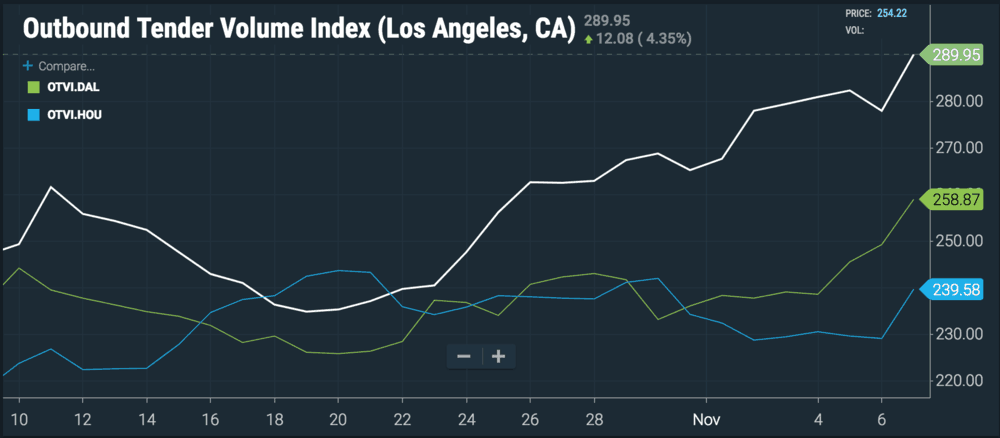Consider Harrisburg
The ports of Los Angeles and Long Beach had an exceptionally strong September and October, and that volume is now beginning to work its way through the country’s freight network. Loads outbound from Los Angeles (OTVI.LAX) reached their bottom on October 19, and have been recovering since then. LA volumes were boosted 23.5% in that period. Initially, turndowns (OTRI.LAX) remained flat, as carriers dumped capacity into the market to handle the elevated volumes—the number of trucks in the city (TRUK.LAX) is a full 7% higher than the available capacity in the market during the June freight surge.
In the past week or so, freight demand growth has started outstripping trucking capacity again on the West Coast. Since October 28, the rate of tender rejections climbed from about 7.5% to 12.2%. This week FreightWaves spoke to executives at three mid-sized trucking carriers who all confirmed that the early October lull in volumes is now behind us, and the market has tightened back up. DAT’s RateView tool reveals how the spot market has reacted to the surge, as dry vans from Los Angeles to Dallas commanded an average of $2.12/mile net of fuel over the past seven days, an increase of 7.6% over October’s average price for that lane. Los Angles to Houston has seen a congruent movement, with dry vans pulling $2.14/mile excluding fuel surcharges over the past seven days, 12% above October.
While it’s important to remember that this freight surge is partially caused by pull-forward from shippers anxious to get their shipments onto American shores before a new round of tariffs hit on January 1, that does not mean that this is not a significant opportunity for carriers and brokers. After all, loads outbound from Los Angeles are the highest they’ve been all year, and we’re beginning to see evidence that the volumes are massive enough to start affecting other regional freight hubs.
We already pointed out that Los Angeles volumes began inflecting upward after October 19, with more aggressive acceleration starting after October 23. Notably, about a week and a half later, Dallas volumes (OTVI.DAL) marched upward, gaining 8.4% since November 4. Yesterday, on November 7, Houston volumes (OTVI.HOU) saw a big uptick, rising 4.5% in a day after stagnating for a month. Although it’s a much smaller market than either Houston or Dallas, note that tender rejections in El Paso (OTRI.ELP) have climbed back up to 30.9%, reaching the top of a monthly cyclical pattern that’s been steady since August.

Atlanta is still relatively quiet, with volume levels (OTVI.ATL) equivalent to mid-May, before the June surge, but outbound loads have increased 3.25% since November 2. We think there’s more volume growth to come out of the Atlanta market because Savannah volumes (OTVI.SAV) are in a healthy place right now, having essentially doubled since the market’s lull in early September. More loads are starting to come out of Joliet, IL, (OTVI.JOT) to the tune of a 6.5% increase since October 26—think of Joliet as Chicago’s version of the Ontario, CA, market on a smaller scale: a suburban market rich with distribution centers and warehouses. Right now, though, trucking capacity (TRUK.JOT) at 107.9% is keeping turndowns suppressed, but according to DAT’s RateView tool, dry van spot prices net of fuel from Joliet to Atlanta climbed to $2.36/mile over the past seven days, up 6.7% from October’s average on that lane.
One potential anomaly we noticed in reviewing freight market data this week is the Harrisburg, PA market. Harrisburg is always a vigorous market, representing 3.17% of the total market share of outbound loads (OTMS.MDT)—compare that to Los Angeles (OTMS.LAX) at 2.94%. More importantly, it’s a very strong headhaul market, meaning that its outbound volumes normally outweigh inbound volumes. Harrisburg’s headhaul index (HAUL.MDT) is at 60, one of the best markets in the country. Although spot prices from Chicago to Harrisburg have deteriorated since their June high at $2.97 net of fuel, dry vans hauling freight from Chicago to Harrisburg have still been charging an average of $2.55/mile over the past seven days.
Yes, we know: the Northeast is normally a black hole for freight, it’s congested, and winter weather is unpredictable but normally… not good. Chicago to Harrisburg is about 650 miles, an awkward 1.5 day transit time, and the Pennsylvania turnpike has expensive tolls. Still, we think that shippers and brokers may be overlooking the fact that trucks going into Harrisburg are almost guaranteed a load out of the market, which should push spot prices down even further. The corollary of that for carriers is that Harrisburg represents an opportunity: if trucks can get $2.55/mile going into one of the best headhaul markets in the country, they should probably consider it.







